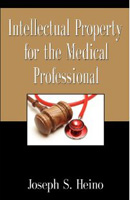 VERDICT: It’s a Keeper
VERDICT: It’s a Keeper
Intellectual Property for the Medical Professional
By Joseph S. Heino (Bradenton, FL: Booklocker.com Inc., 2013). 109 pgs. $13.95. Order, www.amazon.com.
Reviewed by Jennifer Amundsen
Intellectual Property for the Medical Professional, by Wisconsin lawyer Joseph S. Heino, is a slim yet comprehensive guide to the eponymous subject matter. The author’s primary goals, as stated in the introduction, are to set out the basics for identifying intellectual property assets and to summarize steps that can be taken to protect such assets, using examples from the medical field. After a short section that introduces the general concept of intellectual property, the book launches directly into a well-organized discussion of each of the four major types of intellectual property (trademarks, copyrights, patents, and trade secrets). Appropriately, given its intended audience, the book contains a relatively detailed discussion of patent concepts and procedures.
Want to review a book?
The following books are available for review. Please request the book and writing guidelines from Wisconsin Lawyer managing editor Karlé Lester, by email or (608) 250-6127. Reviewers may keep the book reviewed. Reviews of about 500 words are due within 45 days of receiving the book. Reviews are published, space permitting, in the order received and may be edited for length and clarity.
- Banning DDT: How Citizen Activists in Wisconsin Led the Way, by Bill Berry (Madison, WI: Wisconsin Historical Society Press, 2014). 255 pgs.
- Business and Commercial Litigation in Federal Courts, 3rd ed., by Robert L. Haig, editor-in-chief and 251 authors (New York, NY: Thomson Reuters, 2011-14). 12 vols. CD-ROM.
- Legal Abuse Syndrome: 8 Steps for Avoiding the Traumatic Stress Caused by the Justice System, by Karin Huffer (Bloomington, IN: AuthorHouse, 2013). 195 pgs.
- Middle Class Philanthropist: How Anyone Can Leave a Legacy, by Melinda Gustafson Gervasi (Madison, WI: Purple Owl Press, 2013). 80 pgs.
- Ripples in Opperman’s Pond, by Doug Zipes (Bloomington, IN: iUniverse Inc., 2013) (novel). 269 pgs.
- Sweatshops in Paradise: A True Story of Slavery in Modern America, by Virginia Lynn Sudbury (Bloomington, IN: iUniverse, 2013). 163 pgs.
- Unfair Competition: Murder by Gunshot, by Christopher Norgaard (Los Angeles, CA: Crestview Publications, 2013). 131 pgs.
- Worse than the Devil: Anarchists, Clarence Darrow, and Justice in a Time of Terror, by Dean A. Strang (Madison, WI: Univ. of Wisconsin Press, 2013). 268 pgs.
Consistent with the stated goals but going above and beyond the bare bones, the author has tailored the information to his view of what would be most useful to those in the medical field, particularly individuals and small businesses. Given the breadth of the overall topic, this is not unwise. For example, the copyright section contains a discussion of the work-made-for-hire rules, and the patent section contains a discussion of so-called invention-promotion firms, which can be a particular trap for the uninitiated.
Although not a main focus, the book also sensibly provides information about the relationship of intellectual property to processes of the U.S. Food and Drug Administration (FDA). In particular, a discussion of trademark law in this context necessarily implicates the FDA’s rules on drug-name approval. Similarly, a discussion of patent law relating to medical innovations properly includes a discussion of the FDA’s regulatory powers.
The text is generally clear and should be easy for nonattorneys to follow. Another of the author’s stated aims is to avoid the use of legalese and string citations. The latter goal is achieved and, although a lay reader might benefit from explanation of a few terms used in the text (“diversity of citizenship” and “mask works” come to mind), the book largely succeeds in shunning legalese as well. By and large, the goal of providing clarity for the lay reader is met.
The author has succeeded in providing the information necessary to identify and protect intellectual property and has done so in a way that is accessible to the nonattorney reader. Although written with the medical professional in mind, this well-written volume could benefit any nonattorney interested in learning more about how to protect the intellectual property attached to the individual’s business or profession. I heartily recommend it for anyone, medical professional or not, who seeks an introduction to this increasingly important area of the law.
As principal of Amundsen Law Firm LLC, Madison, Jennifer L. Amundsen, U.W. 2003, practices primarily intellectual property, with a focus on trademark and copyright law and business/corporate law.
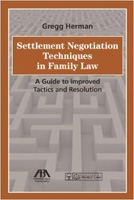 VERDICT: Touchdown!
VERDICT: Touchdown!
Settlement Negotiation Techniques in Family Law: A Guide to Improved Tactics and Resolution
By Gregg Herman (Chicago, IL: ABA, 2013). 188 pgs. $69.95. Order, www.americanbar.org/aba.html.
Reviewed by Nicholas C. Zales
Milwaukee family law lawyer Gregg Herman has written a winning book on negotiation. Ostensibly for family law lawyers, this book has useful A-Z information for any lawyer who negotiates. Herman suggests that lawyers need to learn negotiation skills in the same way they learn litigation skills. This book fits the bill. He argues negotiation may seem intuitive to lawyers but that it is not. It must be learned. He shows you how it works with real-life examples. Settlement Negotiation Techniques in Family Law: A Guide to Improved Tactics and Resolution will make you a better lawyer and negotiator.
Negotiation is an essential part of any family law case. Herman’s book begins with the basics of negotiation: what it is, making an offer, and timing in the lawsuit. It moves on to controlling emotions, preparing the client for settlement, and disclosing assets. The book then gets into the fine points of negotiation that any family lawyer would benefit from reading about: settlement issues specific to family law negotiations, mediation, collaborative divorce, cooperative divorce, and ethics. For family law attorneys, it offers incisive commentaries on almost every kind of negotiation at any stage in the litigation.
The genius of this book is its clear and easy-to-read style. It offers a wealth of negotiation practice tips told as asides. The author freely shares many anecdotes based on his practice. They tie the theory he expounds to the reality of practice. Those asides hammer home key points with great humor. They alone are worth the price of the book. Whether you are new to negotiation or an old hand, you will find something of value here. This book doesn’t just tell you how to negotiate better, it shows you.
Nicholas C. Zales, Milwaukee, Marquette 1989, is a member of the State Bar of Wisconsin Board of Governors and Communications Committee.
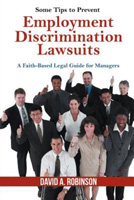 VERDICT: Not for Me, Maybe for You
VERDICT: Not for Me, Maybe for You
Some Tips to Prevent Employment Discrimination Lawsuits: A Faith-Based Legal Guide for Managers
By David A. Robinson (Bloomington, IN: Westbow Press, 2012). 109 pgs. $11.95. Order, www.amazon.com.
Reviewed by Kerri A. Hutchison
Some books are written for a decidedly limited audience, and this is one of them. David A. Robinson has written a short (109-page) book on preventing employment-discrimination lawsuits. Robinson devotes a chapter each to the prevention of race discrimination, gender discrimination, and sexual harassment. Preventing religious discrimination, age discrimination, disability discrimination, and sexual orientation discrimination are covered in one chapter. The book is completed by two chapters on preventing discriminatory language and reducing damages and attorney fees. Throughout the book, Robinson emphasizes the preventive actions employers can take so that employees are less likely to file employment-discrimination lawsuits.
The book is intended for managers, rather than legal experts. It is written in a conversational style that is easy to understand and avoids technical terms. Nevertheless, the writing style was frustrating at times because of Robinson’s propensity to state the obvious (for example, “Our current President, Barack Obama, is a person of color.”) and to clutter his opinions with too many qualifications. At times, he rambles.
According to Robinson, this book varies from other books on employment discrimination in two ways: 1) the incorporation of Biblical teachings, and 2) advice on how to avoid becoming a victim of discrimination. These two differentiating elements were my least favorite aspects of the book.
First, as lawyers, we are trained to advise clients about the law. It is difficult to imagine a client who would also need a Biblical basis for following the law. Even if such a client exists, I found the incorporation of Biblical teachings poorly executed. There were surprisingly few Biblical references for a book that claims to be a faith-based guide. Further, at times, Robinson takes Biblical passages out of context or claims the Bible makes a certain point without providing any citation or text. Robinson describes the Bible as an “excellent equal opportunity guide,” but fails to refute, with any degree of substance, that the Bible has been relied on to justify discrimination at various points in history.
Second, Robinson’s advice on how to avoid becoming a victim of discrimination ranges from bizarre to nonsensical. He advises employees to exercise to prevent age discrimination and be cautious in their sex lives to prevent race discrimination. He advises women to ask men out on dates to end gender discrimination (“if women will ask men for dates and pay for dates as readily as men … women will end male domination in the workplace and in life generally”). I think most women would disagree that male domination can be eliminated simply by initiating dates.
I recommend this book if you have a client who thinks that employment laws contradict his or her Christian faith. For all others, I would skip this book.
Kerri A. Hutchison, Marquette 2007, currently practices as an in-house attorney in Illinois.
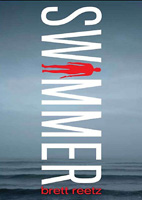 VERDICT: Touchdown!
VERDICT: Touchdown!
Swimmer
By Brett Reetz (Minneapolis, MN: Two Harbors Press, 2011). Novel. $12.60 paperback, $5.99 Kindle. Order, www.amazon.com.
Reviewed by Aaron Frederickson
As a seasoned road warrior who is on pace to log almost 100,000 air miles this year, I enjoy a good book – one that is a page-turner, filled with suspense and easy to pick up and enjoy after a long day in the office. In Swimmer, Brett Reetz provides everything I look for in a book.
This book is a mix between the paranormal of Stephen King and the mystery of David Baldacci. Beginning in the heart of Door County, Reetz takes the reader on the journey of ex-cop and active alcoholic Lloyd Jornt as he teams up with his stepbrother, the local sheriff, to stop a serial killer. At the same time, he attempts to put his life back together by making peace with a troubled past. During the intense investigation, Jornt is led to believe that the cold-hearted killer he and his brother are chasing is not a normal human being. He soon finds out that the mysterious waters of Lake Michigan are hiding secrets, including an elusive “swimming man” who stalks his unsuspecting prey.
As with many good books, the elegance of Swimmer is found in the author’s ability to relate to and describe the struggles average people face in their lives. As is the case with many in life, and in the legal profession, Lloyd Jornt did not have the ideal childhood, which was rocked by the untimely death of his parents. The author also incorporates the protagonist’s alcoholism, his search for reconciliation in troubled relationships, his repeated loss of jobs, and mischief that resulted in an “indirect” murder.
Some may shy away from the book given the paranormal undertones. However, each page brought more suspense that kept me interested until the very end. Based on this factor, this book is a definite “Touchdown!”
Aaron Frederickson, William Mitchell 2002, is director of Medicare secondary payer compliance at Allsup, Belleville, Ill.
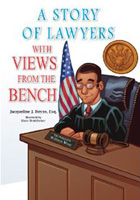 VERDICT: Not for Me, Maybe for You
VERDICT: Not for Me, Maybe for You
A Story of Lawyers; A Story of Lawyers with Views from the Bench
By Jacqueline J. Buyze (Mascot Books, 2012, 2013). 38 pgs. each. $13.45 each. Order, www.amazon.com.
Reviewed by Joe Ahlers
There are a few jobs whose responsibilities children can easily understand: teacher, physician, ice cream seller. Lawyer is not one of them.
At just over 20 pages each, Buyze’s books are about the right length to keep you entertained and do a good job of keeping your attention, mostly because of the very vivid illustrations. The problem is that the books aren’t meant for you (an adult lawyer): they’re supposed to be for children. If the author’s goal was to provide visual stimulation and poetic rhyme to a young child, then job well done; if the intent was to educate children as to what lawyers do, then Buyze fell short by shooting too high in her quest to introduce children to the legal profession.
The biggest failure of the books is the author’s use of terminology and phrasing that, while defined in the glossary, go beyond the reach of the average child. I anticipated res ipsa and joinder would be scrapped in favor of melodic overtures on the daily life of an attorney; instead, we get passages like “S-corps and C-corps and partnerships, too, [corporate lawyers] know what all the entities do”; and “a written Complaint that tells what transpired, and Answer complying with rules are required.” By delving into due process, roles of appellate courts, and why real estate lawyers are apparently very important in a transaction, Buyze focused on the parts of a lawyer’s life that probably mean nothing to the average adult, much less a child.
The books are also boastful in terms of lawyers’ role in society. The first book claims that “in terms of importance… [lawyers are] second to none” and they “often miss lunch.” The second idolizes judges who sit “like a king on a throne.” Her romanticizing of the legal world strives to build up lawyers at the expense of reality. Although I’d like to say I agree that our profession has noble points, there is something to be said for the modesty of letting our work and roles speak for themselves even among children.
In retrospect, reading these books made me wonder whether my children will really care what I do. They may at some point wonder why I have to leave them for an entire day with a caregiver, but a basic “daddy has to go to work to earn money to buy toys and candy” is probably about all most children’s attention spans will permit – at least those targeted by children’s books.
Buyze should get credit for trying to explain what is understandably a difficult-to-comprehend profession (I still haven’t figured it all out myself); parts of these books in fact do a great job of breaking down legal practice into an easy-to-understand concept, but those parts are overshadowed by forced prose and jargon beyond the understanding of the average young child. Unfortunately, by overreaching in her quest to explain lawyer-world, the author missed the mark.
Captain Joe Ahlers, U.W. 2011, is a judge advocate in the U.S. Air Force. He is on the editorial board of the Air Force Law Review and is currently a government prosecutor and the chief of Adverse Actions & Labor Law at Altus AFB, Okla.
